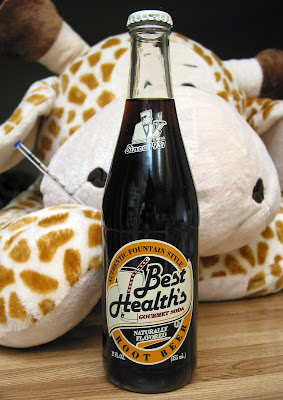Before we begin, I would like to note the appropriate, but coincidental fact that this is my 66th root beer posting. I know the list on the left says this is technically my 67th, but since one of those was only a diet version of another root beer listed, I'm not really counting that one. Onward then...!
 Fill 'er up.
Fill 'er up.On the drive to the Grand Canyon, you’re bound to find plenty of reminders of America-gone-by. Mr. D’z Route 66 Diner, across the street from a power-station-cum-Route-66-museum and still-operating Santa Fe Railroad tracks, is one of those places. The structure was originally a service station, but was converted into a diner and has stayed that way for roughly the past 35 years. It still retains the same road-side charm that draws locals and tourists alike.
But history buffs though we are, that’s not why we’re here. This is why:
 The Pooj looks a little flat.
The Pooj looks a little flat.Current owner Armando Jimenez, a veteran of the Las Vegas restaurant scene, developed the brew along with his brother Nacho. Apparently Oprah liked it so much she had nearly 20 cases shipped to her studio in Chicago to give away to her audience (Big Give indeed…!).
The flavor is a good meld of wintergreen and licorice, sweet, but not too sweet as many HFCS beverages can be. The flavor is actually a little thin for my tastes, like Mug, but not as cloying. Mind you, I’m not saying it tastes like Mug, since those would probably be fighting words in the root beer realm. Mug is cloying and flavorless; Mr. D’z is what Mug wishes it was. Since Mr. D’z also bottles their brew, we can sample again in a controlled environment, away from the train whistle charm and Oprah afterglow…
Although the label says that the bottled version is produced for Mr. D’z by the Black Mountain Brewing Company in Cave Creek, somewhere north of Scottsdale, a quick Google search for the company reveals that it neither operates under that name nor is located in Cave Creek. The brewing company is now called Chili Beer (so named either after owner Crazy Ed Chilleen or after Crazy Ed’s propensity to spitefully drop a Serrano chili in any beer whose owner asked for a wedge of lime, instead of the requested lime) and now operates out of Tecate, Mexico. So I really don’t know where this stuff comes from…
Disputed origins aside, I actually slightly prefer the bottled brew to the fountain version. Its scent starts on the licorice side, with a menthol finish. The initial taste is pretty sweet, with a tangy flavor that I can’t really pinpoint – not quite citrus-y, not quite ginger-y, more like the slightly sour taste you get when something sugary starts to molecularly break down in your mouth. A good root-y flavor follows that, slightly smoky with good blend of wintergreen and sassafras, and a licorice essence that travels up into the nose. I wouldn’t call it caramel-y, like the label claims – I don’t think I would have even thought to look for a caramel flavor if it had not already been described as such on the label and on Mr. D’s menu – but it does have a rich texture I don’t normally get in a HFCS-sweetened root beer (as this one is). Perhaps its brewing company origins (as opposed to simply coming from a carbonated soda plant) are responsible for the added smoothness that’s often lacking in thin HFCS beverages, but I can’t say for sure.
I won’t be pulling an Oprah and carting cases of Mr. D’z Root Beer back home with me – that strange sourness is sadly keeping this brew, which otherwise has a really good flavor, from getting a much higher rating. However, I’ll definitely make a point of stopping in Kingman for a brew every time I’m on this stretch of the I-40. Mr. D’z Route 66 Diner Root Beer gets a high 3.5.






